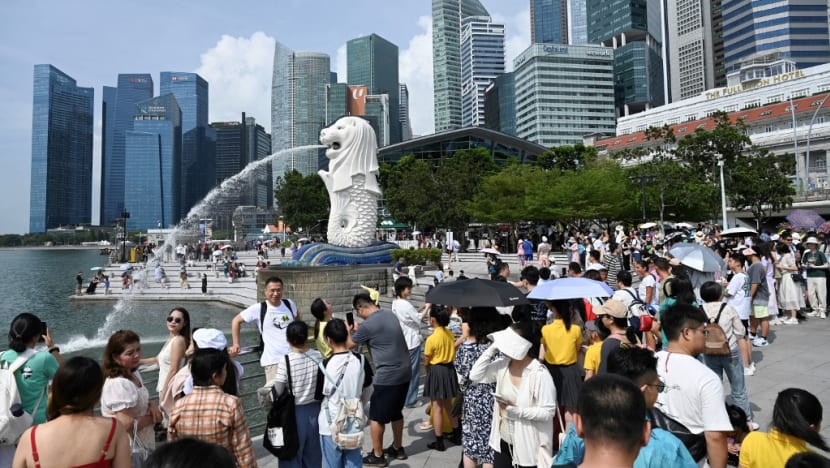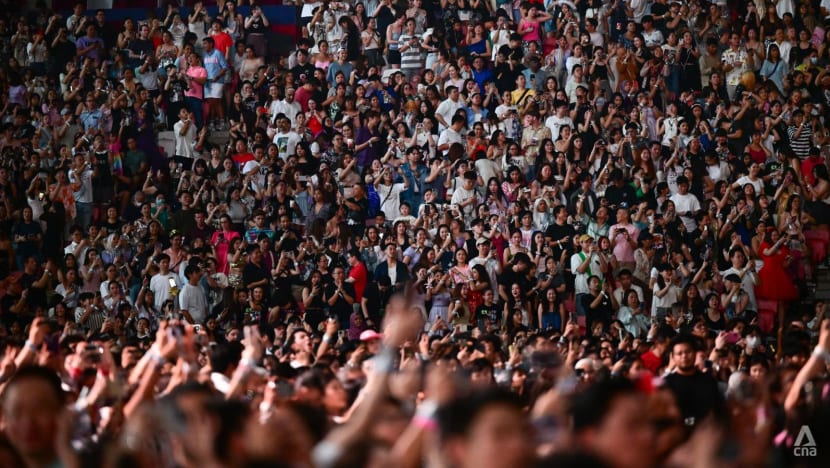Commentary: When will tourist arrivals in Singapore fully recover?
While Changi Airport is nearing a full recovery in passenger traffic, visitor arrivals to Singapore are lagging. The tourism sector faces a complex recovery with rising costs and varying demand, says aviation and tourism analyst Brendan Sobie.

People gather next to the Merlion statue at the Marina Bay Waterfront Promenade in Singapore on Aug 7, 2024. (Photo: AFP/Roslan Rahman)

This audio is generated by an AI tool.
SINGAPORE: Passenger traffic at Singapore’s Changi Airport is now virtually at pre-COVID levels. The airport handled 33.01 million passengers in the first half of 2024, representing a 99.3 per cent recovery compared with the 33.23 million passengers handled in the first half of 2019.
However, visitor arrivals were only 92.6 per cent recovered, with 6.64 million arriving at Changi between January and June compared with 7.17 million in the same period in 2019.
June was a particularly weak month for tourism in Singapore, with visitor arrivals at Changi 85.3 per cent recovered compared with the same month in 2019.
This is a concerning trend highlighting the challenges facing Singapore’s tourism sector, particularly in months without big events, as the cost of holidaying in Singapore skyrockets.
THE TAYLOR SWIFT EFFECT
The Taylor Swift concerts in March provided a welcome boost to Singapore’s tourism sector, with visitor arrivals at Changi nearly matching those of March 2019 at a 99.9 per cent recovery. However, as soon as Swifties left, this temporary high faded. In the second quarter, the recovery rate slipped to 88.5 per cent, down from 96.7 per cent in the first quarter.


The passenger traffic recovery rate at Changi also dipped slightly to 98.2 per cent in the second quarter from 100.5 per cent in the first quarter. However, Changi was able to offset most of the decline in inbound demand with stronger outbound demand.
Outbound traffic, measured by the number of Singapore residents departing Changi, was 5.4 per cent higher in second quarter. In the first quarter, it was 0.6 per cent lower than the same period of 2019 and for the first half of 2024 it was 2.6 per cent higher.
Transit traffic was about 6 per cent higher in the first half of 2024 with a similar recovery rate in each quarter, indicating a growing reliance on passengers connecting through Changi without entering Singapore. Transit traffic accounted for 34 per cent of total traffic in the first half of 2024, compared with 32 per cent in 2019.
While there are more big events scheduled for the second half of the year, including the Formula 1 Singapore Grand Prix in September, it is becoming increasingly difficult to attract tourists when there are no events. The F1 event, unlike the Taylor Swift concerts, may not have as significant an impact since it was already an annual fixture before the pandemic.
IS SINGAPORE EXPENSIVE TO VISIT?
It is not unusual for tourists these days to complain about how Singapore is an expensive place to visit. Recently, an American TikTok user lamented that she spent more than US$9,000 on a five-day trip to Singapore, including US$1,200 a night for her hotel room.
Her post triggered a wave of criticism from netizens, who pointed out that there were a lot of cheaper alternatives. Her post may have touched a nerve, but it highlights the perception of the city as an overpriced destination.
A hotel room in Singapore now costs on average S$280 (US$211) per night, based on Singapore Tourism Board data from the first half of 2024. The average hotel room rate increased by 32 per cent compared to the same period of 2019.
This has been met with a corresponding dip in occupancy rates, which fell from about 85 per cent in the first half of 2019 to 80 per cent in the first half of 2024.
With accommodation costs climbing, Singapore risks pricing out budget-conscious travellers. Although the cost of other items typically purchased by tourists have also increased, affordable options remain for many of these including food, transport and attractions. Therefore, steep hotel rates may prove to be the main impediment to fully recovering Singapore’s tourism sector.
Singapore has announced a series of big investments this year to help its tourism sector amid intensifying global competition. For example, Singapore will get its own Porsche Experience Centre near Changi Airport by 2027 and plans are also in place for a four-hectare waterfront wellness enclave at the Marina South Coastal site.
BALANCING HIGH-END AND BUDGET TOURISM
The new attractions may be successful at luring more high-end tourists and further differentiating Singapore from less expensive destinations. However, Singapore also needs to attract budget or middle-tier tourists to generate the volumes required to support the tourism sector’s overall ecosystem and help fill the significantly larger Changi Airport that will emerge once Terminal 5 opens next decade.
Further increases in the transit portion of Changi’s total traffic may seem like a viable option but this kind of traffic is significantly less profitable for airports as transit passengers pay much lower fees despite using more services. Transit traffic also contributes much less to the overall economy and can instead facilitate growth for a competing destination.
This is the conundrum of investing in air hub expansion. The massive investment in Changi East could be questioned if the breakdown of traffic at Changi flips so that transit overtakes inbound as the biggest segment.
There will be some growth in outbound as well, but this will remain the smallest of the three segments - at roughly one-quarter of total traffic - given Singapore’s small population.
Getting Singapore’s tourism sector back on the growth trajectory will not be easy. The main source markets could be reinvigorated with innovative products and savvy marketing, but will that be sufficient to attract more tourists if costs continue to rise?
HOW CAN SINGAPORE SWAY PRICE-SENSITIVE TRAVELLERS?
Most of the traditional source markets are now struggling and the short-term outlook is not bright.
China has captured a lot of attention since early this year when Singapore waived visa requirements for Chinese citizens and passenger traffic between the two countries returned to pre-COVID levels.
However, Chinese inbound visitor arrivals at Changi are still well below 2019 levels, registering a 10 per cent decline in the second quarter of 2024. The recovery of Singapore-China passenger traffic has been driven by the outbound (including Chinese citizens working in Singapore) and transit segments.
China is still the largest source market for Singapore’s tourism sector, but the inbound portion of total Singapore-China traffic has slipped from 71 per cent in first half of 2019 to 63 per cent in first half of 2024.
Singapore’s second-largest source market, Indonesia, has seen an even bigger drop with Indonesian visitor arrivals at Changi down by 20 per cent in the first half of 2024.
Singapore’s third-largest source market, India, is also not fully recovered. Indian visitor arrivals at Changi were down 12 per cent in the first half of 2024 although India-Singapore passenger traffic is now higher than pre-COVID levels, driven by transit traffic.
India is a booming market with massive outbound growth widely predicted. However, it is also a very price-sensitive market, making it difficult for Singapore to attract as many Indian tourists as other destinations.
Inbound demand from regional markets within Asia have generally been weaker than long-haul markets. For example, Australian visitor arrivals were up 8 per cent in the first half of 2024 compared to 2019 levels while American and British arrivals were down only 1 per cent each.
Demand from Asian travellers has also been impacted by increasing departure fees at Changi, which now total S$65.20. While this may not seem like a lot compared to a hotel room, many regional travellers only stay in Singapore for one or two nights and the S$65.20 is often more than the base air fare offered by a budget airline. AirAsia has dropped six routes at Changi over the last year, a bellwether of how difficult it has become to stimulate inbound demand from other Southeast Asian countries.
As it embarks on its long-term 2040 tourism vision, Singapore should look at initiatives to sway price-sensitive travellers such as more budget accommodation options and lower departure fees for regional flights.
Brendan Sobie is the founder of Singapore-based independent aviation consulting and analysis firm Sobie Aviation.



















